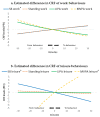The Relation between Domain-Specific Physical Behaviour and Cardiorespiratory Fitness: A Cross-Sectional Compositional Data Analysis on the Physical Activity Health Paradox Using Accelerometer-Assessed Data
- PMID: 33137943
- PMCID: PMC7662405
- DOI: 10.3390/ijerph17217929
The Relation between Domain-Specific Physical Behaviour and Cardiorespiratory Fitness: A Cross-Sectional Compositional Data Analysis on the Physical Activity Health Paradox Using Accelerometer-Assessed Data
Abstract
In contrast to leisure time physical activity (LTPA), occupational physical activity (OPA) does not have similar beneficial health effects. These differential health effects might be explained by dissimilar effects of LTPA and OPA on cardiorespiratory fitness (CRF). This study investigated cross-sectional associations between different physical behaviours during both work and leisure time and CRF by using a Compositional Data Analysis approach. Physical behaviours were assessed by two accelerometers among 309 workers with various manual jobs. During work time, more sedentary behaviour (SB) was associated with higher CRF when compared relatively to time spent on other work behaviours, while more SB during leisure time was associated with lower CRF when compared to other leisure time behaviours. Reallocating more time to moderate-to-vigorous physical activity (MVPA) from the other behaviours within leisure time was positively associated with CRF, which was not the case for MVPA during work. The results of our study are in line with the physical activity health paradox and we call for further study on the interaction between LTPA and OPA by implementing device-worn measures in a longitudinal design. Our results highlight the need for recommendations to take into account the different effects of OPA and LTPA on CRF.
Keywords: CVD risk; FEPA; aerobic workload; cardiorespiratory fitness; compositional data; leisure time physical activity; occupational health; occupational physical activity; physically demanding jobs.
Conflict of interest statement
The authors declare no conflict of interest. The funders had no role in the design of the study, in the collection, analyses, or interpretation of data; in the writing of the manuscript, or in the decision to publish the results.
Figures


References
-
- Vasankari V., Husu P., Vähä-Ypyä H., Suni J., Tokola K., Halonen J., Hartikainen J., Sievänen H., Vasankari T. Association of objectively measured sedentary behaviour and physical activity with cardiovascular disease risk. Eur. J. Prev. Cardiol. 2017;24:1311–1318. doi: 10.1177/2047487317711048. - DOI - PubMed
-
- Piepoli M.F., Hoes A.W., Agewall S., Albus C., Brotons C., Catapano A.L., Cooney M.-T., Corrà U., Cosyns B., Deaton C., et al. 2016 European Guidelines on cardiovascular disease prevention in clinical practice: The Sixth Joint Task Force of the European Society of Cardiology and Other Societies on Cardiovascular Disease Prevention in Clinical Practice (constituted by representatives of 10 societies and by invited experts) Developed with the special contribution of the European Association for Cardiovascular Prevention & Rehabilitation (EACPR) Eur. Heart J. 2016;37:2315–2381. doi: 10.1093/eurheartj/ehw106. - DOI - PMC - PubMed
-
- Department of Health and Social Care . Physical Activity Guidelines: UK Chief Medical Officers’ Report. Department of Health and Social Care; London, UK: 2019.
Publication types
MeSH terms
LinkOut - more resources
Full Text Sources
Medical
Miscellaneous

